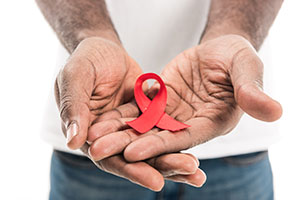HIV Prevention: Partner Services Interventions to Increase HIV Testing
One Pager
This is a brief summary of the CPSTF finding and systematic review evidence for HIV Prevention and Control: Partner Services to Increase HIV Testing. Read a complete summary of the systematic review and CPSTF finding.
This information is also availble in a PDF version.
Summary of Community Preventive Services Task Force Recommendation
The Community Preventive Services Task Force (CPSTF) recommends partner services interventions to increase HIV testing and finds the intervention approach is cost-effective.
Major Findings
The CPSTF recommendation is based on evidence from a systematic review of 27 studies (search period through April 2020). 
- Evidence shows a median of 59.8% of identified partners were notified of possible exposure to HIV infection (10 studies), 55.1% of those notified were tested for HIV (11 studies), and 14.6% of those tested were diagnosed with HIV infection (14 studies).
- Those who received partner services were more likely to be linked to care within 90 days of diagnosis than those who did not (2 studies).
A systematic review of economic evidence from six studies shows partner services interventions to increase HIV testing are cost-effective. The net costs per quality adjusted life year (QALY) gained were cost-saving (2 studies) or had a mean of $25,526 (2 studies), all below a conservative benchmark of $50,000.
What are Partner Services to Increase HIV Testing?
HIV partner services are offered to people with a diagnosis of HIV infection (index patient) and their sexual or needle-sharing partners. Interventions include notification of possible exposure, HIV testing, and related services including prevention counseling, HIV testing, linkage to medical care, and referral or linkage to other services.
Partner notification is an essential component of partner services.1 Trained personnel interview patients diagnosed with HIV infection to learn about their sexual or needle-sharing partners and make plans to confidentially notify partners of their potential exposure to HIV.
Why is This Important?
- Nearly 40% of new HIV infections are transmitted by people who don’t know they have the virus.2
- Among those living with HIV, 15% do not know they have the virus, and another 23% know their status but are not receiving care. People with HIV who are aware of their status can get treatment and remain healthy for many years. Treatments can also dramatically reduce, if not eliminate, the risk of sexually transmitting the virus to HIV-negative partners.3
- CDC estimates the lifetime cost to treat one person with HIV infection is $501,000.4
- Ending the HIV Epidemic: A Plan for America features HIV testing as a key component of the operational plan to reduce new HIV infections in the United States by at least 90% by 2030.5
Learn More
America’s HIV Epidemic Analysis Dashboard (AHEAD)
References
1 Centers for Disease Control and Prevention (CDC). Recommendations for partner services programs for HIV infection, syphilis, gonorrhea, and chlamydial infection. MMWR Recommendations and Reports 2008; 57(RR-9):1-83.
2 Centers for Disease Control and Prevention. HIV Testing. https://www.cdc.gov/hiv/testing/index.html#. June 2020. Accessed 12/7/20.
3 Harris NS, Johnson AS, Huang YA, et al. Vital Signs: Status of Human Immunodeficiency Virus Testing, Viral Suppression, and HIV Preexposure Prophylaxis United States, 2013 2018. MMWR Morb Mortal Wkly Rep 2019;68:1117 1123.
4 Centers for Disease Control and Prevention. CDC’s HIV Work Saves Lives and Money. https://www.cdc.gov/nchhstp/budget/infographics/hiv.html. February 2020. Accessed 1/5/22.
5 Centers for Disease Control and Prevention. Ending the HIV Epidemic: A Plan for America. https://www.cdc.gov/endhiv/index.html. Published July 2020. Accessed 12/7/20.
Established in 1996 by the U.S. Department of Health and Human Services, the Community Preventive Services Task Force (CPSTF) is an independent, nonfederal panel of public health and prevention experts whose members are appointed by the director of CDC. CPSTF provides information for a wide range of decision makers on programs, services, and other interventions aimed at improving population health. Although CDC provides administrative, scientific, and technical support for CPSTF, the recommendations developed are those of CPSTF and do not undergo review or approval by CDC. Find more information at www.thecommunityguide.org.